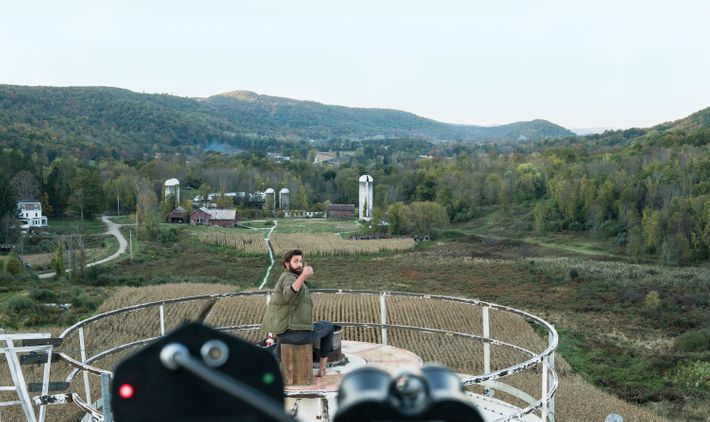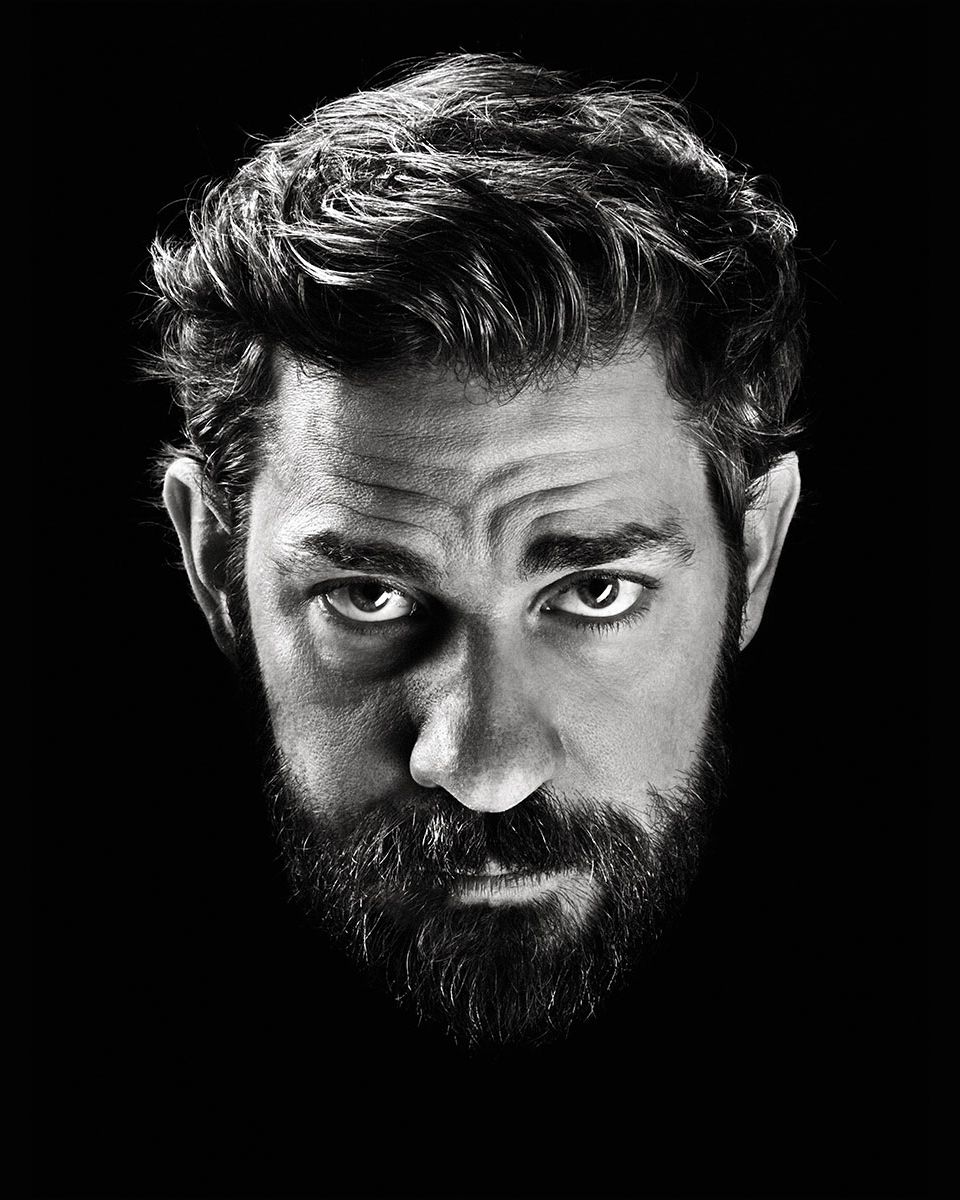John Krasinski is sitting in the dark behind a bank of computers and a full-size movie screen at Warner Bros.’ sound studios in midtown Manhattan. “The thing I worry about,” he says, his legs bouncing with nervous energy, “is hearing more pain.” Bearded and dressed casually in a blue cardigan and jeans, Krasinski is finishing up the sound mixing on A Quiet Place, a horror movie he directed, co-wrote, and stars in. At this moment, a couple weeks before the film’s premiere at the South by Southwest festival in Austin, he’s working on a scene in which his co-star (and wife of eight years) Emily Blunt descends a flight of creaky stairs, trying to be silent. She’s about to step on something sharp. “Play it back,” says Krasinski to a nearby sound editor. Blunt continues softly down the stairs. Thwunk! Gasp! A streak of blood. “That’s great,” says Krasinski, an admitted horror novice, as the scene ends. His co-producer Andrew Form, a horror veteran (he was a producer on the Purge series, among other movies), frowns in concentration behind Krasinski and asks, “Is there too much bone-crunch in the noise? Can we get something wetter?” The sound editor dials up some changes at his computer. The scene plays again. Shwunk! Gasp! Blood. “Yikes!” says Krasinski, elated. “Let’s see that again!”
Unlikely as it might’ve once seemed, the fact that Krasinski — who happily concedes that “played Jim in The Office” (which he did for nine seasons) will appear near the top of his obituary — has directed a movie about an isolated family pitted against supernatural beasts is, in 2018, evidence of two things: his own ambition and how, post–Get Out, the horror genre has become a practicable path to critical respect (and a big box office). It wasn’t that long ago that Jordan Peele was mainly thought of as a sketch comedian rather than as a socially conscious heir to Stanley Kubrick, and though Krasinski didn’t make A Quiet Place as just a shortcut to auteurdom, horror’s newfound stature has to be helpful. But he’ll take our word for it: “It wasn’t a genre where I was thinking, I’ve got to get on that train,” he says during a break for lunch at the sound studio. Prior to being hired for A Quiet Place 18 months ago, “I hadn’t even seen a lot of horror movies.” While he had directed before — episodes of The Office as well as the indie family comedy The Hollars and his own adaptation of David Foster Wallace’s short-story collection Brief Interviews With Hideous Men — he’d never worked with material featuring anything more (or less) frightening than regular folks’ psychological anguish. A Quiet Place, though, gave him a chance to tackle some personally fear-inducing issues head-on and in a commercially viable manner. “Two or three weeks before I got the spec script,” says Krasinski, 38, “Emily had our second daughter. The early days of parenthood are terrifying — hoping that you can keep your child safe and alive. So the theme of the movie was present in my life when I was reading the script. I thought I could take the material somewhere emotionally exciting and” — of course — “make it really scary.”
Form and Brad Fuller, who run the horror-savvy production company Platinum Dunes with Michael Bay and who had originally approached Krasinski with the idea of his starring in the movie, were equally excited. (Bay had been a fan of the actor since directing him in 13 Hours: The Secret Soldiers of Benghazi.) “When John pitched his ideas about the movie,” says Form, “it became clear we had both our star and our director. He wasn’t trying to turn the whole thing into a family drama, but he understood how to inject elements of that and also make a tense movie.” Still, as Krasinski says, “I would imagine Andrew had to work pretty hard with the studio [Paramount] to get them to okay me as a director. I mean, if I’d read that the dude from The Office wanted to direct a horror movie, I’d go, ‘Whoa, that’s a huge swing.’ ” But not a reckless one: Krasinski’s Sunday Night production company has several development deals in the works, and horror is a relatively inexpensive testing ground for directorial talent. (The budget for A Quiet Place was $17 million.) Also, Form notes, while horror was once treated as Hollywood’s blood-spattered stepchild, after the across-the-board triumph of Get Out and It’s unexpected $700 million box-office take, more talent than ever is coming to the genre. “People see that they can go out and crush it at the box office and get 99 percent on Rotten Tomatoes,” Form says. Krasinski felt that shift, too: “Once we were in the editing room” — that is, well after the scope of Get Out’s achievement became apparent — “the studio and producers’ vibe started to change to, If we can make the movie we’re trying to make, this could be a real success.”
That movie is a strange creature. Shot in 36 days last year in the Hudson Valley, A Quiet Place, which Krasinski co-wrote (it’s based on Bryan Woods and Scott Beck’s original screenplay), takes place in an unspecified rural location in contemporary America ravaged by the arrival of blind, sharp-toothed creatures with superior hearing that attack at even the smallest noise. Krasinski and Blunt play a couple trying to keep their young children safe. His character, Lee, is a pragmatic survivalist, focused on getting through each day alive.
Amid all the terror, Blunt’s character, Evelyn, is desperate to maintain a semblance of normal life for the couple’s son, Marcus, played by Noah Jupe, and daughter, Regan, played by the astonishing deaf actress Millicent Simmonds. All of this is done as quietly as possible. “I was anxious about having so little dialogue,” says Krasinski, an excitable talker in real life. “You wonder how you’re going to keep people interested.” He quickly realized that “what I was anxious about became the movie’s superpower.” That epiphany — that what comes before the boo is as important as the boo itself — allowed Krasinski to get a handle on the material. For example, a silent exchange between father and daughter in a key scene was originally in the script as lines spoken aloud, but prior to filming, Simmonds showed Krasinski the American Sign Language translation for the scene’s dialogue. “Her gestures,” he recalls, “were so much more cinematic than saying the words would’ve been.” So silence won out, and now what comes after that scene will both terrify you and pull your heartstrings.
Krasinski also learned how helpful having his wife as a collaborator could be, though persuading her to take the part required some intense negotiating. “We’ve always been quite protective about working together,” says Blunt. “We didn’t want to do something where the narrative around it would just be about our being married.” While some of that is probably inescapable — after all, a married couple is playing a married couple — Blunt was able to overcome her apprehension partly because Evelyn spends much of A Quiet Place separated from Lee. “What I liked about that,” Blunt says, “is that it shows how the concept of the film is so much larger than just one relationship.” That said, there are scenes in the movie that probably test the limits of what couples can put each other through, even fictionally. “Horrible, absolutely horrible,” says Blunt with a laugh about her most grueling scene of silent pain endurance, which I won’t spoil here.

Even after Blunt and Krasinski decided they could work together, the challenge of doing it remained. “Once she signed on,” recalls Krasinski, smiling, “Emily was like, ‘Just so you know, our personality differences are going to be a problem.’ ” He’s the impulsive one; she’s more measured. “I’ll have an idea and want to jump in,” Krasinski explains, “and she’ll want to think about it for three days.” He acknowledges that her approach was an important counterbalance to his own. “The way Emily would put it,” he says, “is, ‘Do you want me to just tell you that your idea is awesome? Or do you want me to feel that it’s awesome?’ ” Says Blunt, “I was quite tough on him sometimes.” During Krasinski’s writing period, she says, “he’d go upstairs to work for, like, eight-hour stretches, and then he’d come down looking like he’d been hit by a truck. I remember being too hard on a scene that he’d been struggling with. But he processed what I was saying and found a solution.” Her husband, she says, “is not a put-his-head-in-his-hands kind of guy.”
Krasinski has been playing the field since The Office ended in 2013, earning his most impressive credits for projects that didn’t involve shooting sardonic glances at paper-company employees. Before the show ended, he co-wrote, co-starred in, and co-produced Matt Damon’s anti-fracking drama, Promised Land; in 2016, he executive-produced Kenneth Lonergan’s Oscar-winning Manchester by the Sea and acted alongside Claire Danes in the Off Broadway play Dry Powder. (He also co-created the Paramount Network’s Lip Sync Battle.) “The phone wasn’t ringing after The Office ended,” Krasinski says. “People needed to let the character of Jim be — or they didn’t think I could do anything else. So it forced me down other paths.” His first job after The Office was The Hollars. “I had to direct something myself to find work,” he says.
Despite the recent notches on his résumé, Krasinski is aware that he has yet to fully transcend the likable-white-guy niche. “I can’t tell you how many times my agent has called me and said, ‘So Ryan Gosling got the part.’ ” Krasinski says. “That’s how it should go, by the way — he’s Ryan Gosling!” But “I think I’m a realist about this business. If A Quiet Place works, it opens up more opportunities.” Should those opportunities not arise, starring in the upcoming Amazon series Tom Clancy’s Jack Ryan, co-produced by Platinum Dunes, which Paramount offered him after seeing him in 13 Hours, is a useful hedge. Both creatively — “Living with a character in a long-form-storytelling way is pretty cool,” says Krasinski — and pragmatically. “It’s helpful to have a constant. Having that allows you to dip into other things in a more daring way.”
Regardless of how A Quiet Place performs — the buzz after the South by Southwest screening was strong — Krasinski is open to doing more horror. His satisfaction with it means that “this is the first time that I’m not coming out of a project thinking, If this works, then that other thing might work, too. I’m so happy just knowing I was able to make this movie — the kind of movie I used to be terrified to watch.”
*This article appears in the April 2, 2018, issue of New York Magazine. Subscribe Now!


